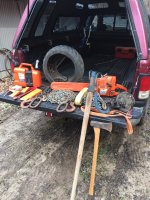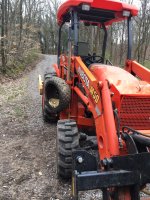MossRoad
Super Moderator
- Joined
- Aug 31, 2001
- Messages
- 65,782
- Location
- South Bend, Indiana (near)
- Tractor
- Power Trac PT425 2001 Model Year
Why does it seem that one can find well performing hydraulic snowblowers, but hydraulic winches are always painfully slow? I mean, you could wrap a cable around a hydraulic snowblower auger shaft and probably move some timber, quite quickly!
I would like to have a SSQA mount hydraulic winch, with free spooling out and remote controlled operation (electric D05 Valve Block) for pulling pine logs out of the bush, as a one man operation.
I have yet to see anything that comes along used, fill this requirement.
I think a winch mounted on a tractor FEL arms are a good way to tweak the arms if the pull isn't exactly straight. Even with a blade dug into the ground, if the angle of the cable is off to the side, and the pull gets hung up, it's gonna want to pull the FEL arms sideways.
Another issue I'd see is that with a remote control on a solenoid on a hydraulic motor.
1. you'd want high engine RPMs to provide high power to the pump to provide high power to the motor.
2. you do not want to put high power to a hydraulic motor immediately. You want to ramp it up.
I know this from experience with my little PT425 and the hydraulic motors on the finish mower and brush cutter. If you try to start them from a dead stop at high engine RPMs, the shock load is very high. Damage will occur eventually.
3. you don't want to turn off hydraulic power to a spinning motor under load and have it stop immediately. Damage will occur.
You need a motor spool valve that allows it to spin down, or, you need to lower pump RPMs to almost idle.
4. if you have a motor spool valve, you may be able to hold a load from spooling back out with a check valve, but then you need a mechanical way to disconnect the cable spool from the drive to allow for free spooling out.
All kinds of things like that that make a hydraulic winch great for recovery due to low speed and high power, but not so great for logging because of the low speed.




